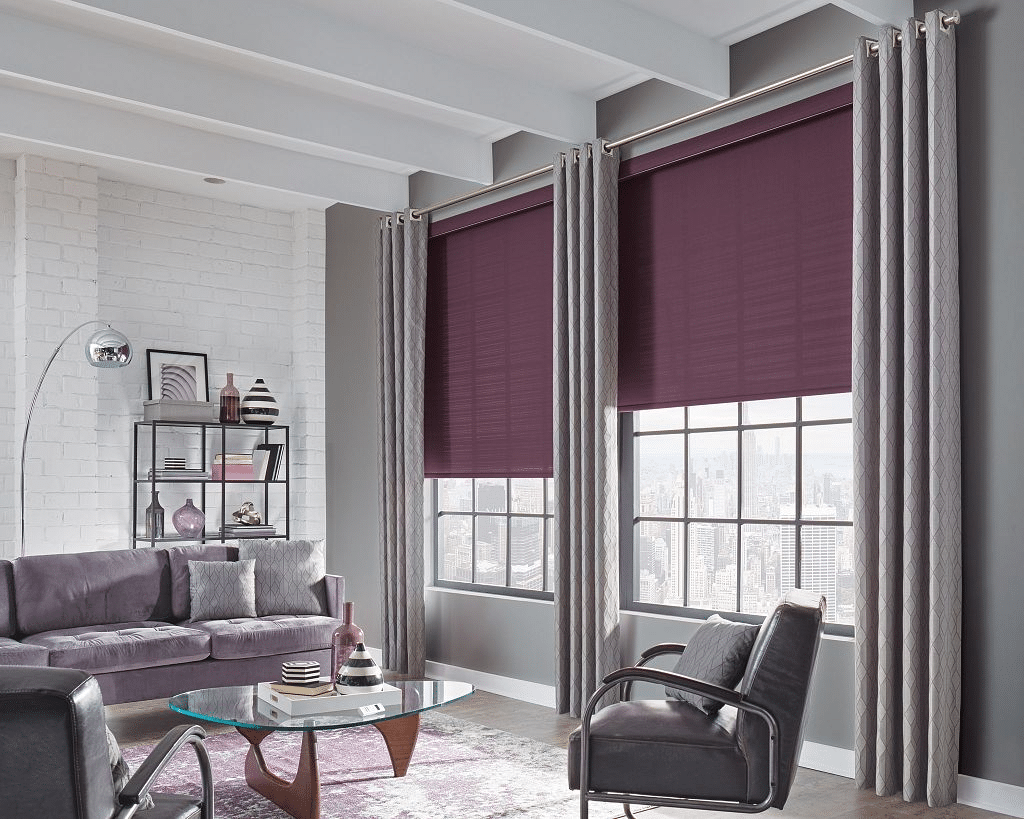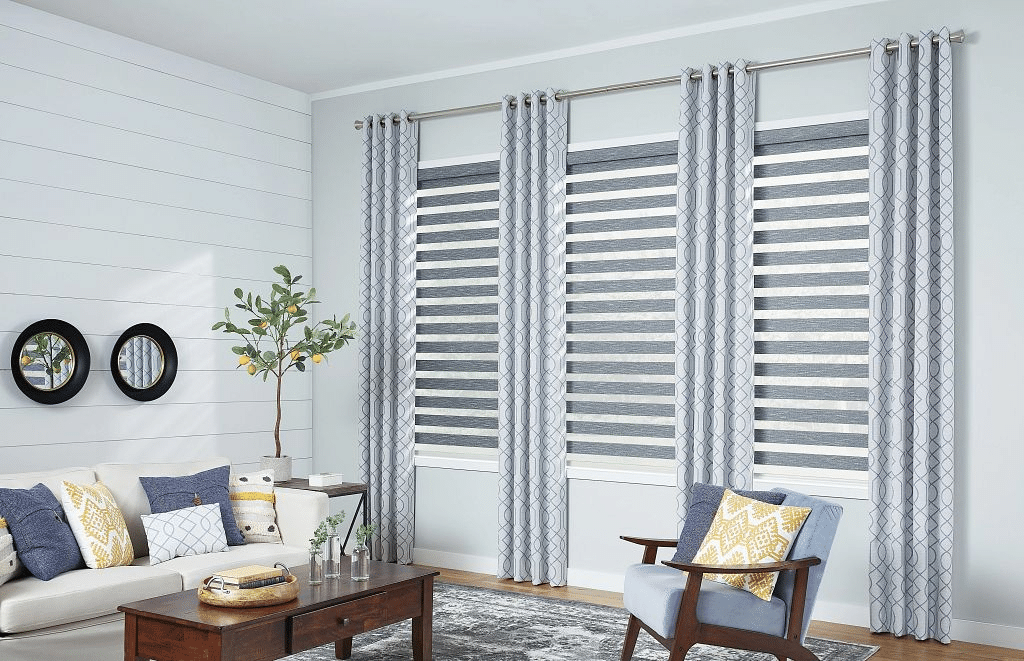The Hidden Cost of Inefficient Windows
You may not realize it, but your windows could be costing you hundreds of dollars a year. According to the U.S. Department of Energy, about 30% of a home’s heating energy is lost through windows during winter, and 76% of sunlight that hits windows becomes heat in the summer. Traditional window coverings offer minimal protection resulting in higher utility bills and inconsistent indoor comfort.
Why Smart Window Treatments Are an Energy-Saving Solution
This is where energy-efficient window treatments come into play. Designed to block excessive heat, reduce cold drafts, and filter harmful UV rays, they are one of the smartest, most cost-effective upgrades an eco-conscious homeowner can make. When thoughtfully selected and properly installed, window treatments don’t just improve comfort they help your home perform better year-round.
Understanding Energy Loss Through Windows
Heat Gain and Loss Explained
Windows are one of the least insulated surfaces in a home. They easily allow heat to enter during summer and escape in the winter. Without effective insulation, your HVAC system works overtime to regulate indoor temperatures. This constant adjustment contributes to energy spikes and higher utility bills.
The Role of Sunlight, Glare, and Insulation
Direct sunlight can warm interiors rapidly, leading to an overreliance on air conditioning. It also causes glare, making spaces less comfortable and less usable. In cooler months, the absence of insulation around window frames invites cold drafts. Energy-efficient window treatments provide a thermal barrier, reducing the burden on heating and cooling systems while maintaining consistent indoor climates.
Types of Window Treatments That Save Energy
Cellular Shades and Honeycomb Blinds
These are among the most effective thermal blinds for reducing energy transfer. Their unique honeycomb structure traps air in individual pockets, creating a natural insulation layer. Double or triple-cell designs offer even more protection. Studies show that cellular shades can reduce heat loss through windows by up to 40% in the winter.
Solar Shades and UV-Blocking Fabrics
Solar shades are designed to block UV rays without completely eliminating natural light. They reduce glare, heat gain, and exposure to sun damage, making them ideal for living rooms, sunrooms, and workspaces. With UV protection built in, solar shades help preserve furniture, flooring, and electronics while reducing indoor temperatures.
Thermal Curtains and Layered Drapery
Thick, insulated drapery especially when layered with sheers or blackout liners adds another layer of defense. Look for curtains made from sustainable materials like organic cotton or recycled fibers with thermal backing. When drawn, these curtains block drafts and trap warm air inside, leading to noticeable energy savings.
Motorized and Automated Window Treatments
Automation enhances the performance of your window treatments by allowing smart scheduling based on sunlight, temperature, and time of day. Set your shades to lower during peak heat hours and rise during cooler periods to let in natural light. Motorized blinds eliminate human error, ensuring optimal performance every day.
How Window Treatments Help Reduce Energy Bills
Temperature Regulation Across Seasons
Whether it’s scorching hot or freezing cold outside, the right window treatment helps regulate indoor temperature by minimizing unwanted heat transfer. In summer, shades or blinds that reflect sunlight keep interiors cooler. In winter, thick drapery or honeycomb blinds trap warm air, helping reduce heating needs.
Reducing HVAC Usage and Energy Spikes
By controlling how much heat enters or escapes through your windows, energy-efficient window coverings reduce the frequency and intensity of HVAC usage. This not only saves money but also extends the lifespan of your heating and cooling systems by reducing strain and wear.
Smart Scheduling for Maximum Efficiency
Automated systems let you program your window treatments to adjust throughout the day. Shades can lower automatically in the afternoon when sunlight is strongest, or rise in the morning to naturally warm your home. When synced with light or temperature sensors, they maximize performance without requiring manual input saving you energy without sacrificing comfort.
Integrating Smart Technology for Better Results
Syncing with Thermostats and Light Sensors
When your energy-efficient window treatments are integrated with smart thermostats or light sensors, your home becomes a self-regulating ecosystem. As temperatures shift or sunlight intensifies, your blinds or shades respond in real-time. This adaptive response ensures optimal comfort while minimizing energy use.
Automation and Voice Control Advantages
Beyon d convenience, automation enables precision. Use voice commands to lower blinds while cooking, or schedule your entire home’s window treatments to adjust before you arrive. This type of proactive energy management not only improves day-to-day living but contributes to a sustainable, tech-savvy lifestyle.
Additional Benefits Beyond Energy Savings
Increased Comfort and UV Protection
One of the most immediate benefits of energy-efficient window treatments is enhanced comfort. By eliminating hot spots, glare, and cold drafts, you create a more enjoyable space to relax, work, or sleep. The UV protection also safeguards your skin and interior furnishings, preserving their color and texture for longer.
Lower Environmental Impact
Reducing your home’s energy consumption doesn’t just help your wallet it helps the planet. Energy-efficient window coverings support eco-friendly living by lowering greenhouse gas emissions linked to power generation. Especially when paired with sustainable materials, this simple upgrade aligns with responsible homeownership.
Extended Lifespan of Furniture and Flooring
Constant exposure to direct sunlight can fade fabrics, warp flooring, and damage artwork. Energy-efficient treatments protect your interiors from UV damage and temperature extremes, prolonging the life and beauty of your furniture, carpets, and décor an often-overlooked form of cost savings.
Conclusion
A Smarter Home Starts with Smarter Windows
Your windows play a major role in your home’s energy efficiency and the right window treatments can make all the difference. From cellular shades to motorized blinds, the options are not only functional but beautifully designed to complement your style and enhance comfort.
By investing in energy-efficient window coverings, you’re not just upgrading your décor you’re improving your home’s performance, reducing environmental impact, and lowering monthly bills.
FAQs
How do window treatments help save energy?
Window treatments act as insulation by blocking heat gain in summer and preventing heat loss in winter. This helps reduce the workload on HVAC systems and leads to consistent indoor temperatures and lower energy consumption.
Which window treatments are best for energy efficiency?
Cellular shades, honeycomb blinds, solar shades, and thermal curtains are among the most energy-efficient. These options provide insulation, UV protection, and can be customized for maximum impact.
Do automated window treatments improve efficiency?
Yes. Automated blinds and shades can be scheduled to adjust throughout the day based on sunlight or temperature, ensuring optimal energy savings with minimal manual effort.
Can energy-efficient blinds protect furniture from sun damage?
Definitely. Many energy-saving window treatments feature UV-blocking materials that prevent fading and deterioration of furniture, flooring, and artwork caused by prolonged sun exposure.
Are energy-saving window coverings worth the investment?
Absolutely. They not only lower energy bills but also increase home comfort, extend HVAC life, protect interiors, and contribute to sustainable living.




